Table of Contents
- Introduction to Angry Cat Body Language
- Common Triggers for Feline Fury
- Interpreting Facial Expressions of Angry Cats
- Decoding Body Postures of Aggressive Cats
- Vocal Cues of an Angry Cat
- Handling an Angry Cat: Dos and Don’ts
- Preventing Cat Aggression: Tips and Strategies
- When to Seek Professional Help for Your Cat
- Training Your Cat to Manage Anger and Aggression
- Conclusion: Nurturing a Happy and Healthy Cat
Introduction to Angry Cat Body Language
Cats are known for their mysterious and often unpredictable behavior. One minute they may be purring contentedly in your lap, and the next they could lash out with sharp claws and teeth. Understanding the body language of cats, particularly when they are angry, can be challenging but is essential for every cat owner.
Angry cat body language is a form of communication that felines use to express their emotions, especially when they feel threatened or uncomfortable. It’s crucial to recognize and interpret these nonverbal cues to prevent aggression and ensure the safety of both the cat and the owner.
Why Understanding Angry Cat Body Language is Important
An aggressive cat can pose a threat not only to other pets and people but also to itself. Cats that frequently exhibit angry behavior may be more prone to injuries, illnesses, and behavioral problems. By recognizing and responding appropriately to their body language, you can prevent aggressive outbursts and help your cat feel more comfortable and secure in its surroundings.
The Basics of Cat Body Language
Cats use a combination of vocalizations, facial expressions, and body postures to convey their emotions. Some common indicators of anger in cats include hissing, growling, flattened ears, and an arched back. However, it’s important to note that these signs are not always a clear indication of aggression and can vary depending on the situation.
In the following sections, we will delve deeper into the different aspects of Cat body language to help you better understand and communicate with your feline friend. By learning to recognize and respond appropriately to their signals, you can build a stronger bond with your cat and foster a more harmonious relationship.

Common Triggers for Feline Fury
Cats can display aggression for a variety of reasons, ranging from fear and anxiety to territorial disputes and boredom. As a cat owner, it’s crucial to identify these triggers to prevent your feline friend from becoming angry or aggressive.
Fear and Anxiety
Fear and anxiety are common triggers for cat aggression. A cat that feels threatened or uncomfortable may lash out in an attempt to protect itself. This can occur in response to a new environment, unfamiliar people, or other pets in the household. It’s important to introduce your cat gradually to new situations and people to help them feel more comfortable and prevent aggressive behavior.
Territorial Disputes
Cats are territorial creatures and may become aggressive when their territory is invaded. This can occur when introducing a new pet or when a neighbor’s cat wanders into their yard. To prevent territorial disputes, ensure that your cat has a designated space to call their own and avoid introducing new pets without proper introductions.
Pain or Illness
Cats that are experiencing pain or illness may become irritable and lash out at those around them. This can be due to physical discomfort or a result of stress caused by their condition. If your cat displays sudden changes in behavior, it’s essential to take them to the veterinarian for a checkup to rule out any underlying health issues.
Boredom and Lack of Stimulation
Cats that are bored or lack stimulation may become aggressive or destructive as a way to release their pent-up energy. Providing your cat with toys, scratching posts, and playtime can help prevent boredom and provide a healthy outlet for their energy.
By understanding the common triggers for feline aggression, you can take steps to prevent or minimize angry outbursts in your cat. By addressing their needs and providing a safe and secure environment, you can help your feline friend feel more comfortable and prevent aggressive behavior.
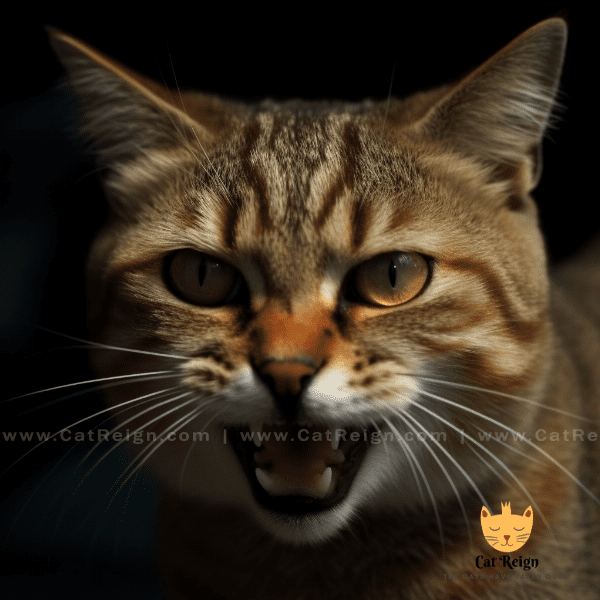
Interpreting Facial Expressions of Angry Cats
Facial expressions are one of the primary ways that cats communicate their emotions, including anger. Learning to interpret these expressions can help you recognize when your cat is feeling angry or upset and take appropriate action.
Dilated Pupils
Dilated pupils are a sign of arousal in cats and can indicate both positive and negative emotions. In the case of anger, dilated pupils are often accompanied by other signs of aggression, such as hissing, growling, or bared teeth.
Puffed Up Fur
A cat that is angry or afraid may puff up their fur as a way to appear larger and more intimidating. This behavior is often accompanied by hissing, growling, or other aggressive behaviors.
Narrowed Eyes
Narrowed eyes, also known as “laser eyes,” can be a sign of intense anger in cats. This behavior often occurs when a cat is focused on a particular target, such as a toy or another animal, and is preparing to attack.
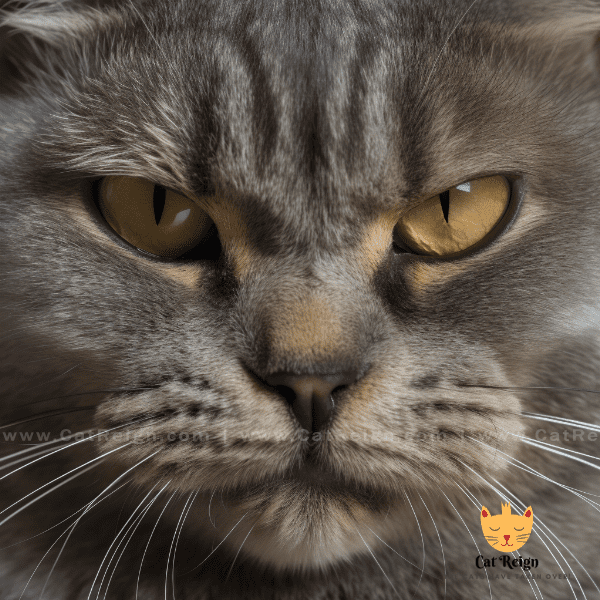
Decoding Body Postures of Aggressive Cats
Body postures are another critical aspect of cat communication and can provide valuable insight into your cat’s emotions, including anger. Understanding the body language of your cat can help you recognize when they are feeling threatened or uncomfortable and take appropriate action.
Arched Back
An arched back is a clear sign of an angry or defensive cat. When a cat feels threatened, their back will arch, and their fur may puff up as they prepare to defend themselves.
Flattened Body
When a cat is feeling aggressive or threatened, they may flatten their body to the ground, as if trying to make themselves as small as possible. This behavior is often accompanied by hissing, growling, or other aggressive behaviors.
Raised Tail
A raised tail can be a sign of both positive and negative emotions in cats, depending on the position and movement of the tail. When a cat is feeling angry, their tail may be raised straight up in the air or lashing back and forth as they prepare to attack.
Crouched Posture
A crouched posture is a clear sign of a defensive or aggressive cat. When a cat is feeling threatened, they may crouch down low to the ground, as if preparing to pounce on their target.

Vocal Cues of an Angry Cat
Vocalizations are another important aspect of cat communication, and understanding the different sounds your cat makes can help you recognize when they are feeling angry or upset.
Hissing
Hissing is a common vocalization that cats use to communicate aggression or fear. When a cat hisses, they are typically warning others to stay away and may be preparing to attack if the threat persists.
Growling
Growling is another vocalization that cats use to communicate aggression. This low, rumbling sound is often accompanied by other aggressive behaviors, such as flattened ears, an arched back, or puffed up fur.
Yowling
Yowling is a loud, high-pitched sound that cats may make when feeling threatened or upset. This sound can indicate pain or discomfort, as well as aggression, and is often accompanied by other aggressive behaviors, such as hissing or growling.
Meowing
While meowing is typically associated with more positive emotions, such as playfulness or affection, it can also be a sign of anger in cats. An angry meow is typically louder and more prolonged than a happy meow and may be accompanied by other aggressive behaviors.
By understanding these different vocal cues and what they mean, you can better interpret your cat’s emotions and respond appropriately. For example, if you hear your cat hissing or growling, it’s best to give them space and avoid approaching them until they have calmed down. On the other hand, if you hear your cat meowing loudly and persistently, it may be a sign that they are feeling angry or upset and need attention or reassurance.

Handling an Angry Cat: Dos and Don’ts
Handling an angry cat can be challenging, but there are several dos and don’ts that can help you manage the situation safely and effectively.
Do: Give Your Cat Space
When your cat is feeling angry or upset, it’s essential to give them space and avoid approaching them until they have calmed down. Attempting to pick up or restrain an angry cat can escalate the situation and result in injury to both you and the cat.
Don’t: Approach Your Cat Head-On
Approaching an angry cat head-on can be perceived as a threat and may trigger an aggressive response. Instead, approach your cat from the side and avoid making direct eye contact, which can be perceived as a challenge.
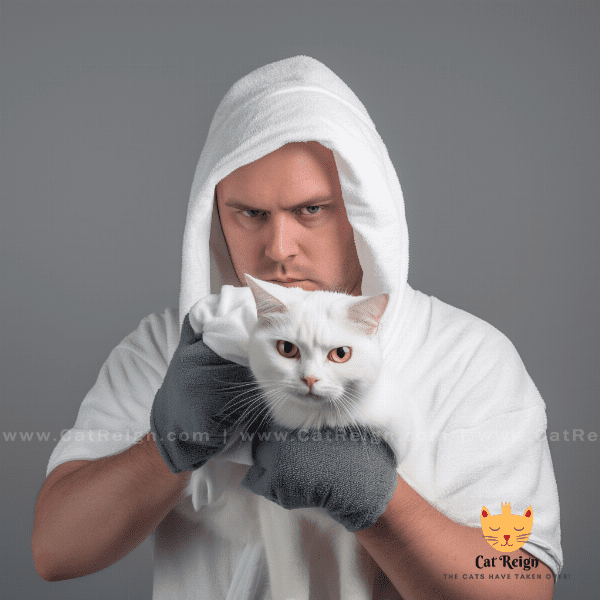
Preventing Cat Aggression: Tips and Strategies
Preventing cat aggression is crucial for the safety and well-being of both you and your feline friend. By following these tips and strategies, you can reduce the risk of your cat becoming aggressive and foster a more harmonious relationship.
Provide Regular Playtime and Exercise
Cats need regular playtime and exercise to help them burn off excess energy and prevent boredom. Providing your cat with toys, scratching posts, and opportunities to play can help reduce their stress levels and prevent aggressive behavior.
Avoid Punishment
Punishing your cat for aggressive behavior can actually make the problem worse. Instead of punishing your cat, focus on identifying the underlying cause of their aggression and addressing it through positive reinforcement and behavior modification techniques.
Ensure Your Cat is Socialized
Socializing your cat from a young age can help prevent aggressive behavior later in life. Exposing your cat to a variety of people, animals, and environments can help them feel more comfortable and confident in different situations.
By following these tips and strategies, you can help prevent cat aggression and foster a more harmonious relationship with your feline friend. Remember, aggression is a natural behavior for cats, and with the proper care and attention, it can be managed successfully.
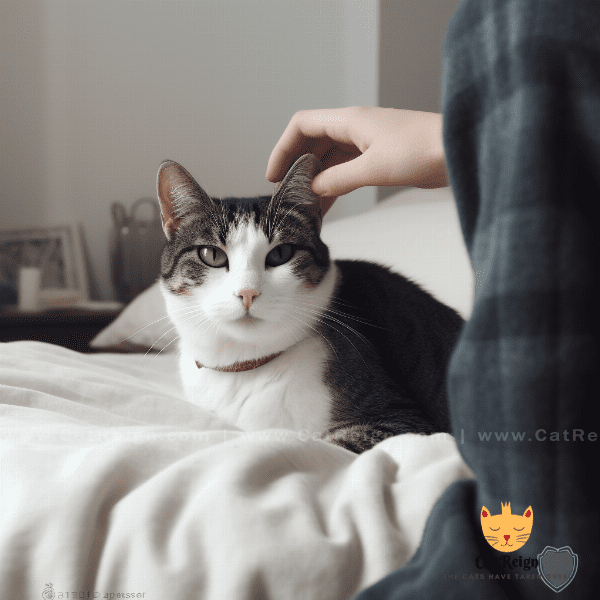
When to Seek Professional Help for Your Cat
In some cases, preventing or managing cat aggression may require the help of a veterinary professional or animal behaviorist. Here are some signs that it may be time to seek professional help for your cat:
Frequent or Severe Aggression
If your cat displays frequent or severe aggression, such as biting, scratching, or attacking people or other animals, it’s essential to seek professional help. A veterinary professional or animal behaviorist can help identify the underlying cause of your cat’s aggression and develop a personalized plan to manage their behavior.
Sudden Changes in Behavior
If your cat displays sudden changes in behavior, such as becoming more aggressive or withdrawn, it may be a sign of an underlying health issue. It’s essential to take your cat to the veterinarian for a checkup to rule out any underlying medical conditions.
Aggression Toward Family Members
If your cat displays aggression specifically toward family members, it may be a sign of a deeper issue, such as anxiety or territorial disputes. Seeking the help of a veterinary professional or animal behaviorist can help identify the cause of the aggression and develop a plan to manage the behavior.
Aggression Despite Behavioral Modification
If you have tried behavioral modification techniques to manage your cat’s aggression without success, it may be time to seek professional help. A veterinary professional or animal behaviorist can provide additional insight and support to help manage your cat’s behavior.
Remember, cat aggression can be a serious issue, and it’s important to take it seriously and seek professional help when needed. With the proper care and attention, most cats can successfully manage their aggression and live happy, healthy lives.
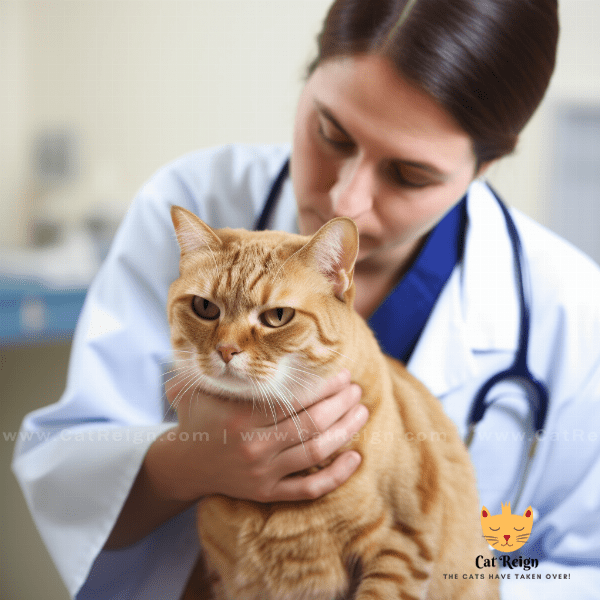
Training Your Cat to Manage Anger and Aggression
Training your cat to manage their anger and aggression can be a challenging but rewarding process. Here are some tips and strategies to help you train your cat to manage their emotions:
Start with Basic Commands
Start by teaching your cat basic commands, such as sit, stay, and come. This can help establish a foundation of trust and obedience and make it easier to teach more advanced commands later on.
Use Positive Reinforcement
Positive reinforcement is a powerful tool for training cats to manage their emotions. Rewarding your cat for good behavior, such as using their scratching post or playing nicely with others, can reinforce positive habits and reduce the risk of aggression.
Teach Your Cat to Redirect Their Aggression
Teaching your cat to redirect their aggression toward appropriate outlets, such as toys or scratching posts, can help prevent them from lashing out at people or other animals. This can be accomplished by offering toys or treats when your cat begins to display aggressive behavior.
Work with a Professional
Working with a professional, such as a veterinary professional or animal behaviorist, can provide valuable insight and support for training your cat to manage their emotions. They can help identify the underlying cause of your cat’s aggression and develop a personalized plan to manage their behavior.
Be Consistent
Consistency is key when training your cat to manage their emotions. It’s essential to establish clear rules and boundaries and consistently reinforce positive behavior.
Training your cat to manage their anger and aggression can be a challenging but rewarding process. By using positive reinforcement, working with a professional, and being consistent, you can help your cat develop healthy habits and live a happy, well-adjusted life.
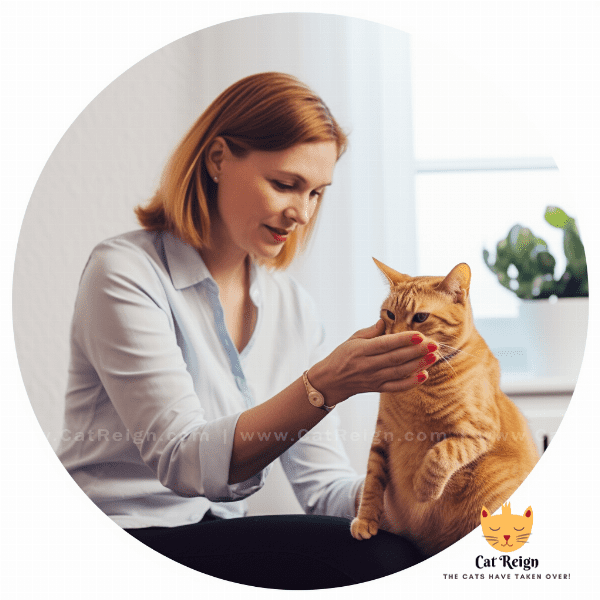
Conclusion: Nurturing a Happy and Healthy Cat
Understanding and managing cat aggression is crucial for fostering a happy and healthy relationship with your feline friend. By learning to recognize and interpret the various cues and signals of cat aggression, you can take steps to prevent and manage aggressive behavior effectively.
From providing regular playtime and exercise to seeking professional help when needed, there are many strategies and techniques you can use to manage your cat’s emotions and prevent aggression. By focusing on positive reinforcement, establishing clear boundaries and rules, and being consistent in your approach, you can help your cat develop healthy habits and live a happy, well-adjusted life.
Remember, every cat is unique, and what works for one may not work for another. It’s essential to approach training and management techniques with patience, kindness, and a willingness to adapt and adjust as needed. With the proper care and attention, you can nurture a happy and healthy cat and enjoy a loving and rewarding relationship with your feline companion.




